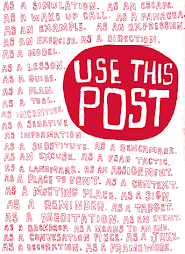it's about the way we do things.
When it comes to education, it has implications in three big areas.
1) curriculum. A lot of what I argue for in schools is we need to re-think the school curriculum. It has major implications for what it is people are meant to learn and understand, which is what the curriculum is.
2) teaching, or pedagogy.
3) assessment — what we reward and the form the reward takes when we come to judge the work.
So this capacity for imagination, to me, is absolutely at the heart of this whole argument.
What I mean is that they go home, not because that’s what they could engage with, but because they can’t find anything else to do. You know, an awful lot of kids with degrees these days are heading home because they can’t earn a living and can’t find a job. And this is really important to me because for years we worked on the premise that getting a college degree is the ultimate objective of going to school. And the premise is, if you got a college degree, you had a job for life. Well, we know that’s simply not true anymore.
And that was my point in the TEDTalk, you know, that when the basic currency of education has defaulted it means that we really have to think again about what we’re doing all this for. There’s a piece in one of the — New York Times or Washington Post recently, but it was about the problems that successful PhD students have in finding work. Well, that’s meant to be the ultimate accolade of an academic career, to get a PhD, but you still can’t get a job. That, to me, is probably the biggest fault line that we need to think about in education. That’s really just a clarification of what I was saying there.
TED is a great example of how distance learning can work well. TED doesn’t have a formal curriculum. But it has new ideas about getting ideas across in a powerful, condensed way, with high-quality visuals, and then syndicating that. TED has shown us a dramatic appetite for new ideas presented in an interesting way.
It’s like what’s too often done with music lessons; kids spend too much time learning scales rather than doing anything interesting. But if you get them right away learning the joy of making music, they’ll want to learn how to do it properly after that.
two things,
1) “teaching creatively”: teachers finding interesting ways into material. Presenting unusual points of entry or interesting angles or perspectives, and enjoying the process of finding them. So, that’s important. Teachers themselves should try to evolve their own creative capacities and enjoy what they do, creatively. Standardized testing has taken the joy of teaching away from them.
2) “teaching for creativity”: creating conditions in classrooms where kids are encouraged to think creatively and imaginatively. Giving them stimulating things to work on. Ideas that will open their mind up. Information they’ve never encountered. Puzzles that will intrigue them. So you might think of that as stimulating the imagination, setting problems.
Being in your element is two things: One is you’re doing something for which you have a natural aptitude. You get it. You’re Julia Childs, you kind of get cooking.
But it’s not enough to be good at something. Many people I know are good at things they don’t like doing. You also have to love it. And if you love the thing you do, then that’s the point I call the element. And, as they say, when you find it, you never work again. People will say to me, “I can’t believe they pay me to do this.”
My premise is that we all have enormous natural talents. Some find them and some don’t. One of the reasons many people don’t find them is because of the way we’re educated. It’s not only about aptitude and passion; it’s also about attitude and opportunity. Feeling that you deserved it. Feeling that you should have it. That you have talents. Having confidence about that. Being willing to work to get it. A lot of people I worked with had to overcome serious obstacles to get to do what they want to do. Social obstacles, or their own fear, or circumstances.
1) art of it is to spend time with yourself introspectively, to meditate even, to be inward-looking, and to think of the times and experience you had where you really did feel an affinity with something you were doing. And the element may be something you did back in your childhood. It may be something you used to do that you stopped doing. Writing, reading, model-making, sports. Maybe you encountered an obstacle. Or maybe you were discouraged from doing it. Or reached a different point in your life.
One of the way to find it, by the way, is not by just kind of jotting it down, words on a page — although that’s often a good way to do it — is to do a storyboard. Take magazines and cut out pictures of things that interest you. Compose a visual collage of things that have always drawn your interest.
2) look outwardly. ..Put yourself in the way of things. ..Expose yourself to possibilities. See what begins to chime with you. My point about being in the element is some people make a living doing it, and others don’t. Some don’t want to. But it’s about finding your own personal element.
____________________________________________




































